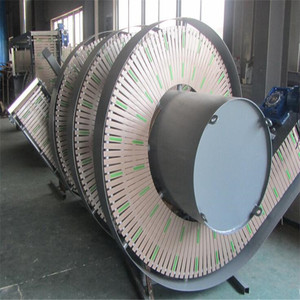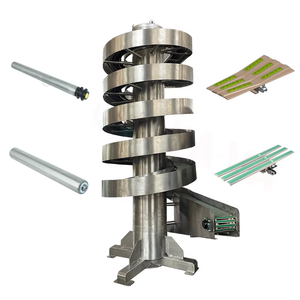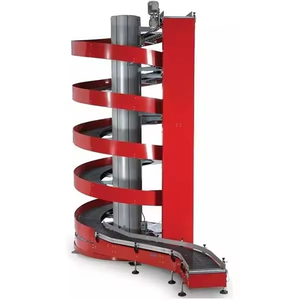
All categories
Featured selections
Trade Assurance
Buyer Central
Help Center
Get the app
Become a supplier

(1954 products available)











































As a transport system, the spiral conveyor simplistically stands out through its cylindrical structure compared to other conveyor types and directly influences various industries. Indeed, this conveyor has integrated forms of rotating and stationary frames under or over a helical material-carrying belt and has become a common phenomena with many materials that require elevation in, for instance, food processing, packaging, and manufacturing industry.
The food processing industry requires high material safety and strict hygiene practices. Spiral conveyors are used to move products like pasta, baked goods, and frozen foods. Their vertical design saves space, which is crucial in facilities with limited floor space. The slow and controlled movement of products on spiral conveyors also prevents damage to delicate food items during transport.
In the packaging industry, spiral conveyors are used to move products from one level to another, such as from a processing area to a packing area. For example, bottles and canned food are transported using spiral conveyors, which assist in efficiently changing the products' height during the process. Spiral belts play the role of enhancing productivity by offering a continuous flow and easy transfer of materials that would otherwise need extra handling or space to elevate.
Other than the food processing and packaging industries, spiral conveyors are relatively found in the warehouse and distribution centers to manage bulk material handling operations. They help tilt and present materials in desired angles or orientations for certain manufacturing assembly lines. Spiral conveyors utilizing plastic belts are common due to their strength and flexibility in conveying various goods to the right height.
Several types of spiral conveyors are available for sale so that specific production demands can be easily met. Key features determining their performance greatly influence the selection of these spiral conveyors.
Maintenance plays a major factor in conveying equipment longevity and reliability. Regular checks of the belt, drive, and alignment of the spiral conveyor prevent minor problems from escalating into major issues. Moreover, cleaning is sometimes a must in certain industries like food processing; they have to clean conveyors to avoid cross-contamination of food products.
For the spiral conveyor, s=h-a relies on quality and safety for all effective functions for many decades, and this is even more amplified in cases where it works under hefty usages or incorporated with risky materials to be conveyed.
In some cases, regular checks and maintenance on some components such as belts, drive, and alignment must always take place to ensure that the conveyor functions correctly and safely. Specifically, in sectors with a massive production load, like manufacturing and warehousing, regular maintenance is crucial to prepare for the next big season.
A spiral conveyor can be selected considering the following aspects and guidelines to guarantee the chosen option will be suitable for some time to come and will meet both productivity and safety standards.
The load-carrying capabilities of the selected spiral conveyor should be considered given the type of materials that will be conveyed. Low-capacity spiral conveyors are just fine for light-duty operations such as transporting some packaged foods, while high-capacity ones are necessary for the quarrying and mineral processing industries to carry extremely hefty items.
Another factor here is the space limitation or availability of extra space for setting up the conveyor. Spiral conveyors are designed to occupy less floor space than the conventional horizontal belts. Hence, they can be installed in areas where space is at a premium and where inclined or declined conveyors cannot work well.
The material of the spiral conveyor belt should be determined by what materials are being conveyed and the industry-specific needs as must be complied with. A steel spiral belt is preferred where heavy, hot, or chemically aggressive materials are handled. A plastic spiral belt for light-duty applications like food processing and packaging where flexibility and corrosion resistance are required.
With energy efficiency becoming a huge factor in all industrial concerns and at a time when the energy cost is so much on the business's operating cost, choosing an energy-efficient spiral conveyor can help save money in the long run. Spiral conveyors with the latest drive systems are designed for efficiency in energy use as they consume less power to move materials.
The maintenance concern must also be taken into account when choosing the spiral conveyor. Some of them include easy-to-maintain features such as easily replaceable belts, covered drives, and accessible bearings to reduce downtime and increase productivity.
A1: A spiral conveyor is a type of conveyor system that moves materials in a circular, vertical, or horizontal direction. Unlike other conveyor systems, which are usually flat and straight, spiral conveyors can save space by providing vertical or inclined transport. Additionally, they can offer a unique way of changing the position of items while still moving them from one area to another.
A2: One of the greatest advantages of using spiral conveyors is the reduction of space from their ability to combine vertical and horizontal motions. Whereas inclined and declined conveyors work in a single plane, spiral conveyors can integrate the two and thus occupy less floor space. Furthermore, because of their circular motion, they may also carry materials around a set path rather than straight.
A3: Spiral conveyors are popularly used by many sectors, particularly those handling products that require vertical transfer, such as food processing, materials handling, and packaging. Other sectors that employ this type also include manufacturing, warehousing, and distribution, seeking better and more efficient vertical moving systems for their products.
A4: The nature of the belt material selected for a spiral conveyor will directly affect its capability by influencing the load-carrying capacity, friction, and durability. A steel belt can be useful where there is a heavy load, tremendous heat, or chemically aggressive materials. A plastic belt can be more flexible, lighter in weight, and resistant to chemical elements, particularly for light-duty use, like in the food processing industry.
A5: Periodic checking and repair of some functional elements such as the belt, drive, and alignment is mandatory for the proper working of the spiral conveyor. In some instances, cleaning is paramount, especially in the food processing area, where hygiene is a major concern The wear and tear of the conveyor should also be watched for and addressed, and it should be 'tracked' for proper belt placement.